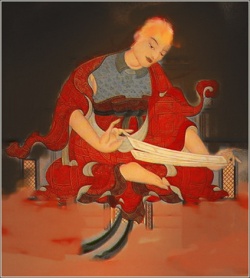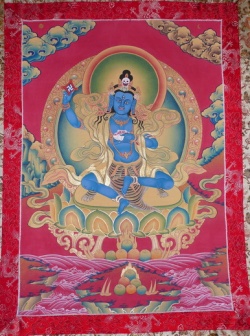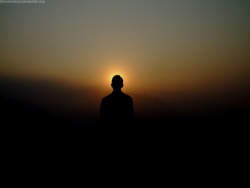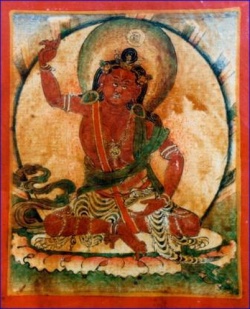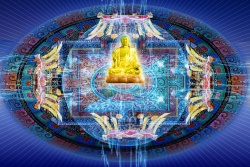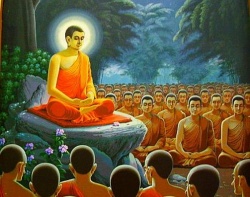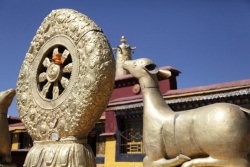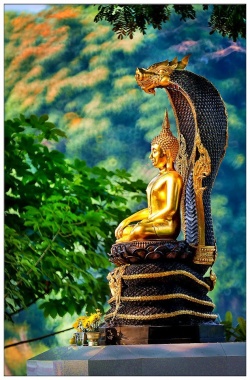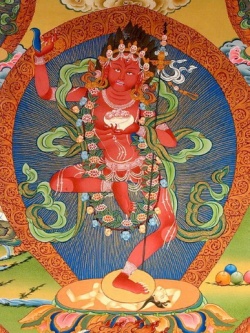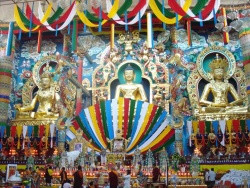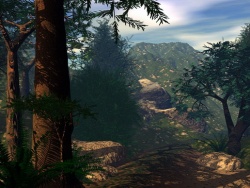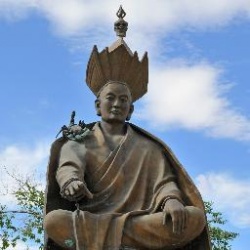Tulku Urgyen Interview
Tulku Urgyen Rinpoche
Interview for Vajradhatu Sun, 1985
The following interview with Tulku Urgyen Rinpoche was recorded on the 16th day of December, 1985, at Nagi Gompa, outside of Kathmandu.
When Rinpoche was asked if he would grant an interview for the Vajradhatu Sun, his reply was, "What is the use of the tiny light of a firefly when the sun has already risen in the sky?" referring to Trungpa Rinpoche's presence in the West.
Q: Can Rinpoche please tell us about his life, his teachers, and the retreats he has done?
R: I was born in Eastern Tibet, in Kham, in the area called Nangchen. The Dharma teaching of my family line is called Barom Kagyu. My grandmother was the daughter of Chokgyur Lingpa, the great terton, so my family line also practices the Nyingma teachings. Since I hold the lineages of both Kagyu and Nyingma, my monastery in Boudhanath is therefore called Ka-Nying Shedrub Ling, The Kagyu and Nyingma Place for Teaching and Practice.
From the time I was quite small until the age of twenty-one, I stayed with Kangyur - the Tripitakamy father who was a Vajrayana teacher and tantric layman. His name was Tsangsar Chimey Dorje. My father was my first teacher and from him I received the transmission for the Kangyur, the entire teachings of the Buddha, and also for the Chokling Tersar, "The New Treasures of Chokgyur Lingpa." Later, I studied with my father's older brother, Tulku Samten Gyatso from whom I received also, among other things, the entire transmission of the Chokling Tersar.
Later on I studied with an incredible great master named Kyungtrul Karjam and from him I received the entire Dam-ngak Dzo as well as Chowang Gyatsa, the Hundred Empowerments of Cutting Practice. He also passed on to me the reading transmission for the Hundred Thousand Nyingma Tantras and the Jangter Gongpa Sangtal, the Northern Treasure of Unimpeded Wisdom Mind. In particular, I received from him a detailed commentary and clarification of the important treasure of Chokgyur Lingpa renowned as Lamrim Yeshe Nyingpo, the Gradual Path of The Wisdom Essence.
From the time I was eight years old, I received teachings on the nature of mind from my own father, and I was lucky later on, to receive detailed instructions in the form of "guidance through personal experience" from Samten Gyatso on the teachings of Dzogchen, the Great Perfection. From my other uncle, Tersey Rinpoche, who was a close disciple of the great siddha Shakya Shri, I was also lucky to receive teachings on Dzogchen.
Moreover, I again received detailed teachings on Lamrim Yeshe Nyingpo from Jokyab Rinpoche, a disciple of Dru Jamyang Drakpa. The body of teachings known as Rinchen Terdzo, the Precious Treasury, I received from Jamgon Kongtrul, the son of the 15th Karmapa. As for the other of the Five Treasuries, I received the Gyachen Kadzo from my third uncle, Sang-ngak Rinpoche, the Kagyu Ngakdzo from H.H. the 16th Karmapa himself, and the Sheja Kunkyab Treasury from Tana Pemba Rinpoche. I addition, I have received the root empowerments of Jigmey Lingpa from H.H. Dilgo Khyentse Rinpoche several times.
In Eastern Tibet I spent three years in retreat just reciting the Mani. [Laughs]. Later on at Tsurphu, the seat of the Karmapas, I also spent three years in retreat and then again in Sikkim I was able to spend almost three years in intensive practice. Lately, I have been here at Nagi Gompa for a few years. That's my life story.
Q: What lineages does Rinpoche hold?Gampopa
R: My family line is the holder of the Barom Kagyu teachings which originate from Gampopa's disciple Barom Dharma Wangchuk. His disciple was Tishi Repa whose disciple was called Repa Karpo. His disciple again was Tsangsar Lumey Dorje. His disciple, Jangchub Shonnu of Tsangsar, is in my paternal ancestral lineage. The line of his son and his son again, all the way down to my father, is called Tsangsar Lhai Dung-gyu, the Divine Bloodline of Tsangsar.
My incarnation line is called Chowang Tulku. With that same name I am just the second. My past life was said to be an incarnation of Guru Chowang. Nubchen Sangye YesheHe was also said to be an emanation of one of the twenty-five disciples of Padmasambhava called Nubchen Sangye Yeshe, but who knows that for sure. [Laughs]. My former life, Chowang Tulku, was a "secret yogi." No one knew how his practice was, but when he passed away his body shrunk down to the size of one cubit without decomposing.
Q: What does Dzogchen mean?
R: Dzog, "perfection" or "completion," means as in this quote from a tantra, "Complete in one - everything is complete within mind. Complete in two - everything of samsara and nirvana is complete within this."
"Dzog" means that all the teachings, all phenomena, is completely contained in the vehicle of Dzogchen; all the lower vehicles are included within Dzogchen. "Chen," "great," means that there is no method or means higher than this vehicle.
Q: What is the basic outline of practice according to the Dzogchen path?
R: All the Buddha's teachings are contained within nine gradual vehicle of which Dzogchen, the Great Perfection, is like the highest golden ornament on a rooftop spire, or the victory banner on the summit of a great building. All the eight lower vehicles are contained within the ninth which is called Dzogchen in Tibetan, Mahasandhi in Sanskrit [and the Great Perfection in English]. But Dzogchen is not contained in the lowest one, the shravaka vehicle. So when we say "perfect" or "complete" it means that all the lower yanas are perfected or completely contained within the Great Perfection, within Dzogchen.
Usually we say that Dzogchen, sometimes called Ati Yoga, is a Dharma tradition but actually it is just the state of one's mind, basically.
3rd Karmapa, Rangjung DorjeWhen it comes to combining these following two points into actual experience, we can use the statement of the 3rd Karmapa, Rangjung Dorje, "It is not existent as even the buddhas have not seen it." This means that the basic state of mind is not something that exists in a concrete way; even the buddhas of the three times have never perceived it. "It is not non-existent as it is the basis for both samsara and nirvana. This is not a contradiction, it is the middle path of unity." Contradiction is like having fire and water on the same plate. Its impossible. But that is not the case here. The basic nature is neither existent nor non-existent - these two are an indivisible unity. "May I perceive the mind nature free from extremes." Usually when we say "is" it contradicts "is not." And when we say "non-existent" it contradicts "existent." But this middle path of unity is devoid of such contradiction. When it is said "to attain the unified state of Vajradhara," that actually refers to what I discussed here.
This unity of being empty and cognizant is the state of mind of all sentient beings. There is nothing special about that. A practitioner should encompass that with "a core of awareness." That is the path of practice. Again, "the unity of being empty and cognizant with a core of awareness."
The special feature of Dzogchen is as follows: "Primordial pure essence is Trekcho, Cutting Through." This view is actually present in all the nine vehicles, but the special quality of Dzogchen is what is called "The spontaneously present nature is Togal, Direct Crossing." The unity of these two, Cutting Through and Direct Crossing, Trekcho and Togal, is the special or unique teaching of Dzogchen. That is how Dzogchen basically is. That's it.
Q: That is a very wonderful teaching. It seems like Dzogchen is very direct and doesn't seem to have a linear quality in terms of the way one would approach it. In the other yanas sometimes one would first do the set of preliminaries, then a yidam practice. tsa-lung practice etc., this and that. It seems like Dzogchen is very immediate, like the essence is already present, available. Is there any kind of linear path in the way one would approach these teachings or is it always direct, like this?
R: We do in the Dzogchen tradition have the gradual system of preliminaries, main part and so forth. But the special characteristic of Dzogchen is to introduce or point out directly the naked awareness, the self-existing wakefulness. This is for student who are suitable, meaning those who have sharp mental faculties. In stead of going through a lot of beating around the bush, one would introduce them directly to their mind essence, to their self-existing awareness.
Dzogchen is said to have great advantage but also great danger. Why is this? Because all the teachings are ultimately and finally resolved within the system of Dzogchen. This can be divided into two parts, resolving all the teaching through intellectual understanding and through experience.
To resolve through experience is what is the great advantage or benefit in the sense that having pointed out and recognizing directly naked awareness and simply makes that the main part of practice. That is the point when there is an incredible great benefit because that itself is the very direct and swift path to enlightenment.
On the other hand, the great danger is when one just leaves it as intellectual understanding, that "In Dzogchen there is nothing to meditate upon. There is nothing to view. There is nothing to carry out as an action." That becomes just a concept of nihilism and is completely detrimental to progress. This is because the final point of the teaching is conceptlessness, being beyond intellectual thinking. Yet, what has happened is that one has created an intellectual idea of what Dzogchen is and holds on to that idea very tightly. This is a major mistake that can happen. So, it is very important to take the teachings into one's personal experience through the oral instructions of one's teacher. Otherwise, simply to have the idea "I am meditating on Dzogchen" is to completely miss the point.
Self-existing wakefulness is present within the mind-stream of all sentient beings since primordial time. This presence is something which should not be left as theory, but should be acknowledged though one's experience. One first recognizes it, then trains and attain stability in it. That is when it is said that Dzogchen has great benefit. There is actually no greater benefit than this.
Great danger means that when this is left as words of mere intellectual understanding then one doesn't gain any experience but merely holds some concept about it and lack the nonconceptual quality. Conceptual mind is merely intellect whereas experience to remain in the continuity of naked awareness; growing used to it what is called "experiencing."
It is the same principle whether one talks of Madhyamika, Mahamudra or Dzogchen. As is said in the Bodhicharya Avatara, "When one's intellect holds neither the concept of concreteness nor of inconcreteness, that is the state of not conceptualizing." As long as one is not free from concepts, one's view remains as mere intellectual understanding and the Dzogchen view is then left as mere theory. One might then think "Dzogchen is primordially empty, it is free from a basis. There is nothing to meditate upon, no need to do anything If I meditate in the morning, I am a buddha in the morning. When I recognize at night, I am a buddha at night. The destined one does not even have to meditate."
Actually, Dzogchen is the way to purify the most subtle obscuration of dualistic knowledge - it is something quite in credible. But if one only imagines it, if it is a mere theory, thinking "I don't need to do anything, neither meditate nor practice," [one's has completely missed the point]. There has been many people thinking like this in the past.
Compared to straying into an intellectualized version of Dzogchen, it is much more beneficial to practice according to Madhyamika or Mahamudra where one goes along step by step, alternating theory and experience within the structure of theory, experience and realization. Proceeding gradually in this way one becomes more and more clear about what is to be resolved and then finally captures the "dharmakaya throne of nonmeditation." In this graduated system there are some reference points along the various paths and levels. But in Dzogchen the master will from the very beginning point out the nonconceptual state, instructing the student to remain free from concepts. It then happens that some student will think, "I am free from concepts, I am never distracted!" while walking around with vacantly gazing eyes. That is called straying into intellectual understanding.
Later on, when we have to die, mere theory will not help us whatsoever. Tilopa told Naropa, "Theory is like a patch. It will wear and fall off." After dying, we will undergo various pleasant and unpleasant experiences, intense panic, fear and terror. Intellectual understanding will not be able to destroy those fears; it cannot make confusion subside. So, merely to generalize that one's essence is devoid of confusion is useless. It's only a thought, another concept, which is ineffective at the moment of death when it comes to deal with one's confusion.
Q: What will help then?
R: One needs to recognize the view of one's essence. If one hasn't thoroughly acknowledged the correct view but only constructed it from concepts, this intellectual understanding will be useless. Its like knowing that there is a delicious meal to be eaten. Without putting it into one's mouth one will never know what is tastes like. Likewise, one needs to be totally free from the merest flicker of doubt concerning the state of naked aware ness. Jigmey Lingpa said about having stability in awareness, "At this point there is no need for 100 panditas and their thousands of explanations. One will know what is sufficient. Even when questioned by these scholars, one will not give rise to doubt. So the main point is to be stable in awareness through experience.
This awareness is not introduced through an intellectual understanding where one only has the idea of it. When a qualified master encounters a worthy student it is like iron striking flint creating fire immediately. When such two persons meet together it's possible to be free from doubt.
When one doesn't feel any doubt, no matter how much one may try, that is the proof of having recognized the mind essence. But if it's possible to start doubting, thinking "I wonder how it is, what shall I do?" that is the proof of having mere intellectual understanding.
This difference between theory and experience is what I basically meant by saying that Dzogchen has both great benefit and great danger.
When a practitioner is introduced to naked awareness he will be able to attain enlightenment in that very body and lifetime because in the moment of recognizing the essence of awareness, the obscuration of dualistic knowledge is absent. This is called "touching the fruition." In this respect there are three ways: taking ground as path, taking path as path, and taking fruition as path. Receiving the pointing-out instruction means that one takes fruition as path. That is why it is so precious. So don't let it stray into mere theory.
Experience is said to be the "adornment of awareness." Awareness is present within all beings; whoever has mind has awareness since it is the mind's essence. The relationship between mind and awareness is mind being like the shadow of one's hand and awareness being the hand itself. In this way, there is not one single sentient being who does not have awareness. We might hear about awareness and then think "I understand, awareness is just such and such." This mental construct is totally useless - from the very first the absence of mental fabrication is crucial. As is said, "Within the naked dharmadhatu of non- fabrication."
Introducing awareness means to point out the absence of mental fabrication. Otherwise it becomes an introduction to mere discursive thought. [Laughs]
Q: What is the difference between the practice of Dzogchen and that of the Anuttara Yoga Tantra in the system of the New Schools, (gsar ma)? It was taught that all the eight lower vehicles are contained within Dzogchen, so how does the difference come about?
R: In the system of the New Schools, there are first of all the four tantras of Kriya Tantra, Charya Tantra, Yoga Tantra, and Anuttara Yoga Tantra. The fourth is divided into Father Anuttara Tantra, Mother Anuttara Tantra and Nondual Anuttara Tantra. This correspond exactly to the structure of the Old School, Nyingma, in that father tantra of Anuttara is Mahayoga, mother tantra is Anu yoga and the nondual tantra is Ati Yoga, [[[Dzogchen]]]. However, there are no explicit teachings on Togal in Anuttara. That is the main difference, whereas it is taught that there is no difference whatsoever between "essence Mahamudra" and Dzogchen in meaning - only in terminology.
Concerning the inclusion of the lower vehicles in the highest is "All phenomena of samsara and nirvana are included with the expanse of awareness." That is the meaning of "inclusion."
Q: There are many kinds of conceptual practices in Anuttara Yoga such as visualization and manipulations of the nadis and pranas. How do the fit into the Dzogchen system?
R: These practices actually belong to the systems of Mahayoga and Anu yoga. However, in Ati Yoga which should be effortless, free from fixation, these practices are applied as "means for enhancement." Q: From where does the tradition of giving the transmission of the pointing-out instruction originate?
R: The first origin is what we call the "mind transmission of the victorious ones." Buddha-SamantabhadraAfter that there was the "sign transmission of vidyadharas" and today we have the "oral transmission of great masters." First, the mind transmission of the victorious ones, was when the manifestation aspect of Samantabhadra appeared in a bodily form and the five families of victorious ones recognized dharmata by merely seeing this bodily form. Garab DorjeThis was mind transmission through simply manifesting as a deity without the need for any conversation. This mind transmission seems to have gradually degenerated. Following that, by means of the sign transmission of vidyadharas such masters as Garab Dorje, Shri Singha and Guru Rinpoche recognized the self-existing wakefulness of dharmata through a simply gesture such as a finger pointing at the sky. Finally, Guru Rinpoche, The Eight Indian Vidyadharas as well as the Tibetan King, Subject and Companion [[[Trisong Deutsen]], Vairotsana and Yeshe Tsogyal] and so forth gave teachings through oral transmission. This oral transmission which comes from India and is not a Tibetan invention, was originally imparted by whispering through a copper tube such as in the case of Vairotsana into whose ear was whispered the sentence, "The single sphere of dharmakaya, self-existing wakefulness, inconceivable reality, is present within the mind of sentient beings. Oral transmission literally means "transmitted into the ear."
In the case of the Kagyu lineage, Tilopa stated, "I have no human masters. My master is Vajradhara himself." Marpa Chokyi LodroSo, figuratively speaking, Vajradhara gave the teachings to Tilopa and Tilopa transmitted them orally to Naropa who then passed then on to Marpa. He gave them to Milarepa and he again to Gampopa from whom they were orally transmitted to the "four great and eight lesser lineages.
VimalamitraIn the case of the Nyingma lineage, Guru Rinpoche, Vimalamitra and Vairotsana passed the teachings on chiefly as an oral transmission to the Twenty-five Disciples headed by the King, Subject and Companion. Here Dzogchen was transmitted as the pointing-out of the expression of awareness; not to awareness itself but to its expression which is dharmata. From this point, the Twenty-five Disciples passed the teaching on to the Eighty Tibetan Siddhas and others such as the various oral lineages as well as the treasure lineages, so that this transmission has been uninterrupted down until our own root guru. If the lineage had been broken there would be no pointing-out and recognition
of awareness.
Q: Why is this pointing-out instruction considered so important?
R: That is self-evident. Isn't awareness the actual path for attaining enlightenment? There is nothing more important than recognizing it and become a buddha [laughs]. If you put all the riches in the world on one side and the pointing out of awareness on the other, awareness will be more valuable for enlightenment.
Q: Having received the pointing-out instruction and recognized, will that itself be sufficient or how should one train?
R: Once one has received the pointing-out instruction there is the chance of either recognizing it or not. But a student who has actually recognized will have enough for this entire lifetime in the "single sufficient instruction." The same goes for the bardo state. Yet, one can still apply the paths of Mahayoga and Anu yoga for enhancement and for clearing away hindrances. Once one has recognized one's essence, it is like a fire that only will blaze up more intensely the more firewood is added; the fire will never diminish with the adding of wood. Similarly, there will be benefit from applying the paths of Mahayoga and Anu yoga; even Hinayana practice will be beneficial.
According to one's ability one can apply what one feels inclined towards - like gathering honey from many different flowers. Or, simply to cultivate and practice the recognition of awareness alone will be sufficient for attaining enlightenment within this body and lifetime. All the different practices of Mahayoga and Anu yoga, as in the system of Jamgon Kongtrul the First, are for the purpose of attaining stability in awareness. While benefiting beings one can become more stable in awareness. As I already mentioned, fire blazes up and increases the more wood is added; it is not the opposite way.
Having recognized one's essence, one should sustain its continuity. There will be no benefit from simply leaving it with "I have recognized!" It is necessary to maintain the continuity of awareness until all confusion and conceptual thinking has been exhausted. That itself is the measure; when thoughts are exhausted then it is enough. There is no more need for meditation or for "sustaining the continuity."
Q: Although Rinpoche has a large monastery in Boudhanath, Kathmandu, I notice that he spends most of his time up at Nagi Gompa Retreat Center. Why is that?
R: As a matter of fact, it is said, "In this age of degeneration, carry the burden of the Doctrine. If you are not able to do so, simply the fear that the teachings will die out occurring in your mind for but instant will have tremendous merit." For this reason, the purpose of building a monastery with a gathering of the sangha of monks - as just an image of the doctrine in this dark age - is that we have the great hope that they will practice the tradition of the Dharma. Whether or not the monks individually do any practice is their own business. But if they just wear the robes on their bodies, cut the hairs on their heads and gather together in a group of merely four monks, the benefit of accumulating merit and purifying one's obscurations will result from the respect, faith and donations one can make as a benefactor, no matter how insignificant one's contribution or faith may be. This is independent of whether or not the monks misbehave or misappropriate their donations; that is totally up to themselves. For the benefactors, their will be the blessings of the Buddha when they make a donation to a gathering of just four monks. Their will be no failure in that for the patrons themselves. It is for this reason that I took the effort to build a monastery. Moreover, this age is the time when Buddhism is slowly dying out, like the sun about to depart while setting over the mountains in the west. Considering this combined with having received the command of His Holiness Gyalwa Karmapa, we have constructed this insignificant monastery.
The place up a Nagi Gompa was initially build by the meditator and hermit Kharsha Rinpoche as a hermitage for his following of monks and nuns. After he passed away, the place was offered to Karmapa who then placed me as a caretaker. So I, this old man here, is just a caretaker [laughs]. That is the only reason why I live up here; I am not at all like Milarepa, living in mountain retreats and caves after renouncing samsara. But I have a nice spot to sleep on and a warm place in the sun [laughs]. That is how I live.
Q: What is the benefit and purpose of doing retreat practice?
R: With many distractions one is not able to practice the Dharma properly. Distraction means a lot of business, noise and things to do. When going up in the mountains there will be less distraction. That is the reason for mountain retreat. In addition to that, if one is able to keep some discipline, remaining in solitude without allowing outsiders to visit and not going out oneself, there will be no other distraction than that made by one's own mind. External distractions have been eliminated. That is the purpose of seclusion.
When distractions have been abandoned one can exert oneself in the practice. Through exertion it is possible to destroy confusion. When confusion falls away, enlightenment is attained. That is the whole reason [laughs].
Q: Finally but not least, does Rinpoche have any special advice for the readers of Vajradhatu Sun who are primarily householders?
R: They should first of all receive the pointing-out instruction and recognize their essence. Having recognized, they should refrain from losing its continuity and then mingle that with their daily activities. There are basically four kinds of daily actions traditionally called moving, sitting, eating and lying down. We don't always only sit or only move about; we alternate between the two. In addition we eat, shit and sleep. So there actually seem to be five kinds [laughs]. But at all times, in all situations, one should try not to lose the continuity of the practice. One should try to be able to mingle the practice with daily life. As one gets more accustomed, any amount of daily life activities will only cause nondualistic awareness to develop and become the adornment of this undistracted awareness, free from being obscured or cleared.
When one is able to mingle practice with the activities of daily life, these activities will then be beneficial and devoid of any harm whatsoever. That is if one has already recognized one's essence correctly. Without the correct recognition one will get carried away by the daily activities - one will have no stability. Lacking stability is like a strand of hair in the wind bending according to how the wind blows whereas a needle will be stable no matter how small it is. Even a very thin needle cannot be bent by the wind. Once one has truly recognized one's essence one cannot be carried away by the activities of daily life, just as a needle that is stable. Dualistic mind is completely unstable, like a hair that is just ready to move by the tiniest breeze; it falls prey to the five external sense objects. Awareness, on the other hand, when properly recognized, does never fall subject to sense objects. It is like a needle that is unmoved by the wind.
—Translated by Erik Pema Kunsang. © Rangjung Yeshe Translations & Publications, 1985.
This interview appeared in the Vajradhatu Sun, in an abbrieviated form.
Some of the questions were asked by Dana Chubb.
Surrounded by white mountain cliffs, the valley of Meshö is like an open lotus flower and the foothills covered with meadows and forests. Flowers grow abundantly in summertime and water flows here and there. In the middle, the heart of the lotus, is a huge white rock with a cave in the center called Padma Shelpuk, the Lotus Crystal Cave. The rock, cave and surrounding area are all white in color. The cave contains many naturally appearing images and letters. Yeshe Tsogyal practiced in a small cave to the left, which has windows which also appeared naturally, though they look man-made. The practice caves of Vairotsana and Shri Singha with their naturally-appeared thrones are at the top of the rock.
The Padma Shelpuk, which people called the Ghost Cave, was a cave no one dared visit. Whoever went there was eaten right away. People sometimes saw a one-eyed woman they said was the ghost. A bald-headed man riding on a goat was also seen. Chokgyur Lingpa, Jamyang Khyentse and Jamgön Kongtrül went there knowing that they would receive the Dzogchen Desum terma. People said (about Chokgyur Lingpa), “Today Kyater is going to take out a terma. The ghost will eat him.” Someone else said, “Since Khyentse and Kongtrül are here maybe he will indeed take out a terma.” Then a large crowd followed the three masters.
Many rainbows appeared in the sky. On arriving, they made a big burnt offering. Kongtrül offered the serkyem, the offering to the Dharma protectors, and Khyentse, holding a vajra, sang the Lhasum Damdrak song of command to the local deities. People said (about Jamyang Khyentse Wangpo), “Something special must be happening today because Tulku Rinpoche is doing something.” Everyone was then told to recite the Vajra Guru mantra and to supplicate Guru Rinpoche. The three masters and some others went inside the cave while those who could not fit stayed outside by the opening.
As everyone chanted the Vajra Guru mantra and the Seven Line Prayer, Chokgyur Lingpa’s experience blazed. Normally you can’t reach it, but he flew up and reached the ceiling. . From the ceiling he extracted the terma box containing Dzogchen Desum. As the terma object, he took sacred medicine and nectar blessed by Shri Singha, as well as some hairs of Yeshe Tsogyal and Vairotsana. The terma box was wrapped in one of Guru Rinpoche’s garments. Chokling blessed Khyentse, Kongtrül and everyone nearby with the terma box. People now knew he was a true tertön. Chokling told them, “All who came here are most fortunate. If things work out, I have many things left to do. The kindness of Guru Rinpoche and his consort is inconceivable..” Jamyang Khyentse continued, “Chokling is a great tertön, a very precious one. His terma teaching is extremely precious, as is this place. Everyone should make offerings and circumambulations. The three of us have now opened the gate to this sacred place. When you die, you will all go to the Copper Colored Mountain -- I promise.”
